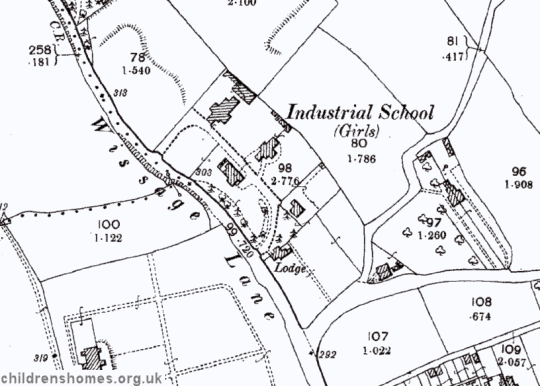Stafford County Council Girls' Industrial School / Wissage Remand Home, Lichfield, Staffordshire
The Stafford County Council Girls' Industrial School was established in 1889 in purpose-built premises at Wissage Lane (now Road), Lichfield. (Its location is also sometimes referred to as being Trent Valley Road, off which Wissage Lane ran.) The founding of the School was largely due to the efforts of Sir Smith Child who also contributed £1,000 towards the construction of the buildings.
The School could accommodate 25 girls and consisted of two blocks and a separate school room. Although the premises were certified for operation on October 30th, 1889, no children were sent to the School until March, 1890. Management of the School was undertaken by a Committee of the Staffordshire County Council. Miss S.B. Higginbotham was initially appointed as superintendent but was soon succeeded by Miss Elizabeth Heslop. Miss Peasland was assistant matron.
In addition to classroom lessons, the girls were occupied in keeping the house clean, and in the kitchen and laundry. All received lessons in plain needlework and knitting.
In October, 1894, an new block was brought into use which could accommodate 30 girls. The School was now licensed to receive 55 in total.
The School site is shown on the 1902 map below.

Stafford County Council Girls' Industrial School site, Lichfield, c.1902.
An inspection report in 1896 noted that the premises comprised six buildings: two houses for 25 and 30 girls respectively, matron's house, detached schoolroom and laundry, and entrance lodge. The girls carried out housework in the two homes and the matron's house. The girls made their own clothing including dresses and outfits. Twenty of the girls also did a little embroidery and fine work. Cookery classes were held in each house. Only the School's own washing was done in the laundry. Classroom performance in mental arithmetic and composition was generally rated as good, and geography as fair. The girls learned singing (sol-fa) and performed a cantata at Christmas. Extension exercises were carried out once a week and there was a field for the girls' use in addition to the playground. Walks were taken at least once a week and the girls went out on messages at all times. A dentist visited quarterly and inspected all teeth. No corporal punishment was administered. A mark system, giving rewards for good conduct, and a loss of food luxuries for misbehaviour, was found to be sufficient.
In 1898, the girls gave three public performances of a cantata and a summer trip to the seaside was arranged using the proceeds. In September, a party of the older girls visited the city gallery and museum in Birmingham. Various excursions were also made to Milford and other country resorts in the neighbourhood.
Miss Heslop continued as superintendent until at least 1922. The establishment had by then adopted the name of The Wissage School.
In 1925, a steady decline in the number of girls being placed at the School led the Council to order its closure which took place on September 20th of that year. The furniture and other contents of the building were sold by auction early in 1926.
After standing empty for ten years, the building was formally re-opened in October, 1935, as the Centre for County mental Welfare, providing daily training for children who were unable to receive education under normal conditions but could not go to residential institutions. They were intended to be taught to do handicraft work so that they could learn to earn their own living.
From 1941 to 1949, the site was used as an isolation hospital. In 1950, the premises became a council-run reception centre known as 'The Homestead' which could accommodate 34 children. By the 1960s, the buildings were occupied by the Wissage Remand Home, housing 24 boys and 12 girls, later known as the Chadswell Assessment Centre.
The buildings were demolished in the 1980s and modern housing now covers the site.
Records
Note: many repositories impose a closure period of up to 100 years for records identifying individuals. Before travelling a long distance, always check that the records you want to consult will be available.
- Staffordshire County Council Children and Family Services access to social care records. No records appear to survive for the Industrial School. Council may hold Homestead / Remand Home / Assessment Centre records.
Bibliography
- Higginbotham, Peter Children's Homes: A History of Institutional Care for Britain's Young (2017, Pen & Sword)
- Mahood, Linda Policing Gender, Class and Family: Britain, 1850-1940 (1995, Univeristy of Alberta Press)
- Prahms, Wendy Newcastle Ragged and Industrial School (2006, The History Press)
Links
- None noted at present.
Except where indicated, this page () © Peter Higginbotham. Contents may not be reproduced without permission.


